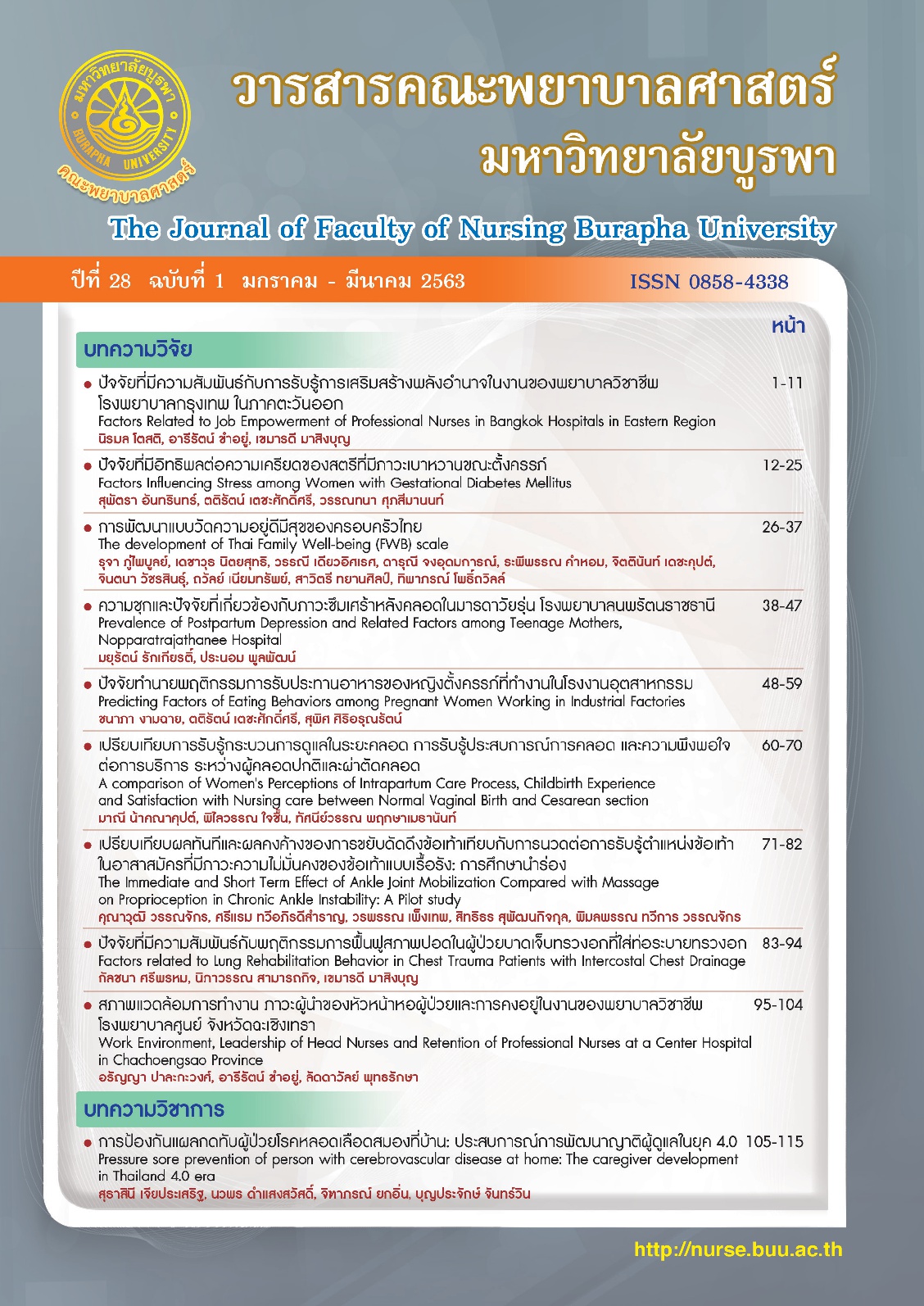Factors related to Lung Rehabilitation Behavior in Chest Trauma Patients with Intercostal Chest Drainage
Keywords:
pain, anxiety, knowledge, behavior, lung Rehabilitation, chest trauma Patients, intercostal chest drainageAbstract
Abstract
Chest trauma patients with intercostal chest drainage who have ineffective lung rehabilitation behavior are at risk for lung atelectasis and infections. This research aimed to examine relationships among pain, anxiety, knowledge and lung rehabilitation behavior in chest trauma patients with intercostal chest drainage. Sample were 84 chest trauma patients with intercostal chest drainage from Sappasitthipasong Ubonratchathani hospital. Data were collected from March to December 2018. Research instruments included personal information record form, pain questionnaire, anxiety subscale of hospital anxiety and depression Scale [HADS-A], knowledge about lung rehabilitation and lung rehabilitation behavior questionnaires. Descriptive statistics and Pearson’s product moment correlation coefficient were used to analyze data.
The results revealed that samples had low level of pain, anxiety, and knowledge about lung rehabilitation (M = 4.72, SD = 1.67; M = 7.19, SD = 4.21; M = 11.00, SD = 4.21 respectively), and moderate level of lung rehabilitation behavior (M = 30.27, SD = 7.59). There was significantly negatively correlation between pain and anxiety with lung rehabilitation behavior. (r = -.34, p <.01, r = -.22, p <.05 respectively). There was no association between knowledge of lung rehabilitation and lung rehabilitation behavior (r = .06, p >.05). The findings suggested that healthcare providers should assess pain and anxiety and provide effective pain and anxiety management in acute phase in order to enhance continuity of effective lung rehabilitation behavior in chest trauma patients with intercostal chest drainage.
References
Bloom, B. S. (1968). Learning of mastery. Evaluation Comment, 1(2), 29-62.
Eren S., Esme H., Sehitogullari A., & Durkan A. (2008). The risk factors and
management of posttraumatic empyema in trauma patients. Injury, 39, 44-49.
Faul, F., Erdfelder, E., Lang, G. A., & Buchner, A. (2007). G*Power: A flexible statistical
power analysis program for the social, behavioral, and biomedical sciences.
Behavior Research Methods, 39(2), 175-191.
Health Education Division, Ministry of Public Health. (2018). Health literacy and
health behaviors. Nonthaburi: Health Education Division. [In Thai]
Jirawatkul, A. (2014). Statistics in research appropriate selection. Bangkok:
Witthayaphat. [In Thai]
Karmy-Jones, R. K., Holevar, M., Sullivan, V., Fleisig, A., & Jurkovich, G. J. (2008).
Residual hemothorax after chest tube placement correlates with increased
risk of empyema following traumatic injury. Canadian Respiratory Journal,
15(5), 255-258.
Karnasuta, P. (1995). Behavioral Science Research. (2nd ed.). Bangkok: Chulalongkorn
University Printing House. [In Thai]
Khlongyant, P. (2001). Pain Experiences, Depression, and Pain Management in the
Hospitalized Elderly Patients. Mahidol University. Bangkok. (in Thai)
Laura, D. C. (2009). Guidelines for the insertion and management of chest drains.
Doncaster and Bassetlaw Hospitals, 1, 1-14.
Laws, D., Neville, E., & Duffy, J. (2003). BTS guidelines for the insertion of a chest
drain. Tharax, 58, 53-59.
Lenz, E. R., Pugh, L. C., Milligan, R. A., Gift, A., & Suppe, F. (1997). The middle-range
theory of unpleasant symptoms: An update. Advances in Nursing Science,
19(3), 14-27.
Lewis, S. M., Heitkemper, M. M., & Dirksen, S. R. (2000). Medical-surgical nursing:
Assessment and management of clinical problems. (5th ed.). Philadelphia:
Mosby.
Mohammed, H. M. (2014). Chest tube care in critically ill patient: A comprehensive
review. Egyptian Journal of Chest Diseases and Tuberculosis, 64, 849-855.
Munroe, B. (2011). Assessment, monitoring and emergency nursing care in blunt chest
injury: A case study. Australasian Emergency Nursing Journal, 14, 257-263.
National statistical office. (2016) [Cited 18 October 2017]. Available from: http://www.otp.go.th/uploads/tiny_uploads/PDF/2560-10/25601018-
Safty2559.pdf
Oksue, N. (2012). Effects of Pulmonary Rehabilitation Program on Fluid Drainage and
Satisfaction with Care in Patient with Intercostal Close Drainage. Chest Disease Institute Journal, 10(2): 19-29. [In Thai]
Pituksung, A. (2011). The study of anxiety, stress and information required of the
preoperative outpatients. Siriraj Nursing Journal, 4(1), 35-42. [In Thai]
Prasittipath, T. (2008). The Experiences of Chest Drainage of Persons with Chest
Trauma. The Journal of Faculty of Nursing Burapha University, 16(1), 51-62. [In Thai]
Prompak, P. (2012). Effectives of Social Support Program for Lung Rehabilitation in
chest Trauma Patients with Chest Tube Drainage. The Journal of Faculty of
Nursing Burapha University, 20(2), 45-58. [In Thai]
Ritkeaw, K. (2010). The Alteration of the Pulmonary Mechanics among Chest Injured
Patient in Critical Phase: A Literature Review. Thai Journal of Nursing Council,
25(3), 78-87. [In Thai]
Sawangsri, K. (2017). Pain management in patients undergoing open heart surgery.
Thai Journal of Cardio-Thoracic Nursing, 28(1), 2-15. (in Thai)
Srisatidnarakul, B. (2010). The Methodology in Nursing Research. (5thed.). Bangkok: You
and I Inter media. [In Thai]
Sumonwong, W. (2017). Nursing care for the patients with chest trauma. (3rd ed.).
Chonburi: Trio advertising and media Co. Ltd. [In Thai]
Tung, H. H., Jan, M. S., Huaung, C. M., Shin, C. C., Chang, C. Y., & Liau, C. Y. (2011).
Using the theory of planned behavior to predict the use of incentive
spirometry among cardiac surgery patients in Taiwan. Heart & Lung, 40(5),
440-447.
Unhasuta, K. (2003). The Effects of Patient’s Participation in Nursing Care on
Pulmonary Rehabilitation in Chest Injured Patients with Chest Drainage. The
Thai Journal of Nursing Council, 18(1), 1-15. [In Thai]
Wongrattana, C. (2001). Statistical methods Research. 8thed. Bangkok: P.B. Foreign
Book Centre. [In Thai]
Zigmond, A. S., & Snith, R. P. (1983). The hospital anxiety and depression scale.
Acta Psychiatrica Scandinavica, 67(6), 361-370.





